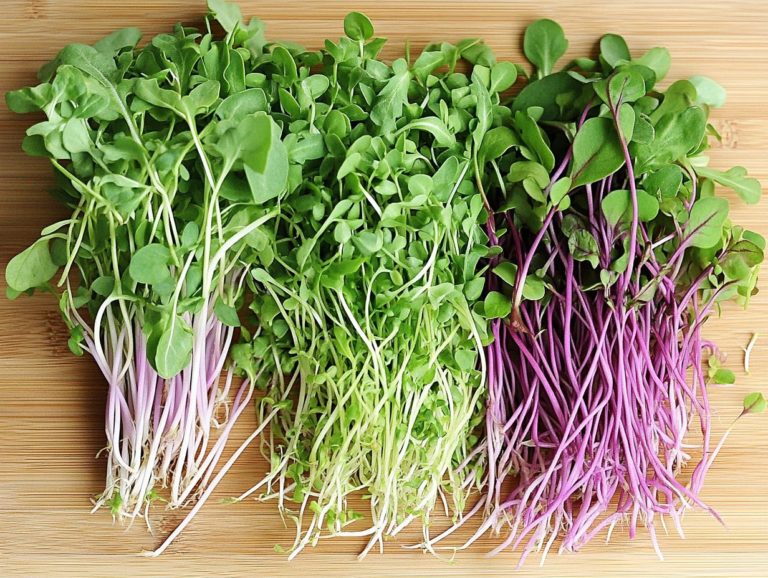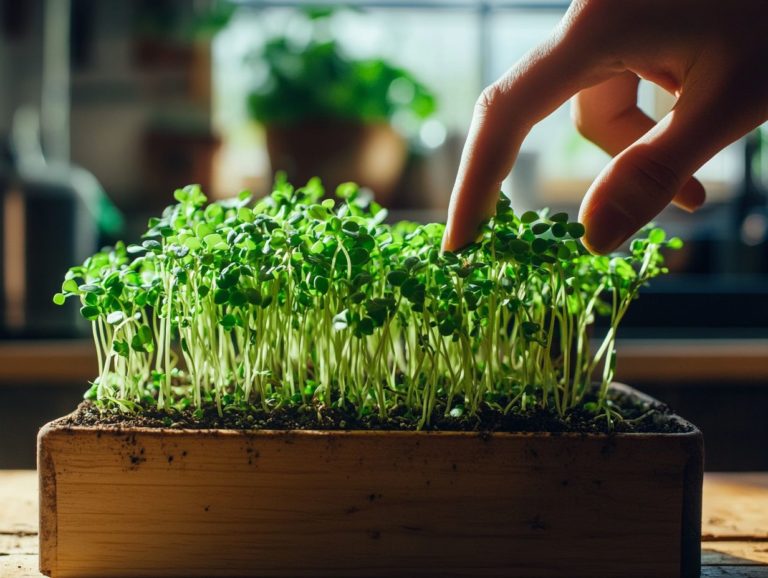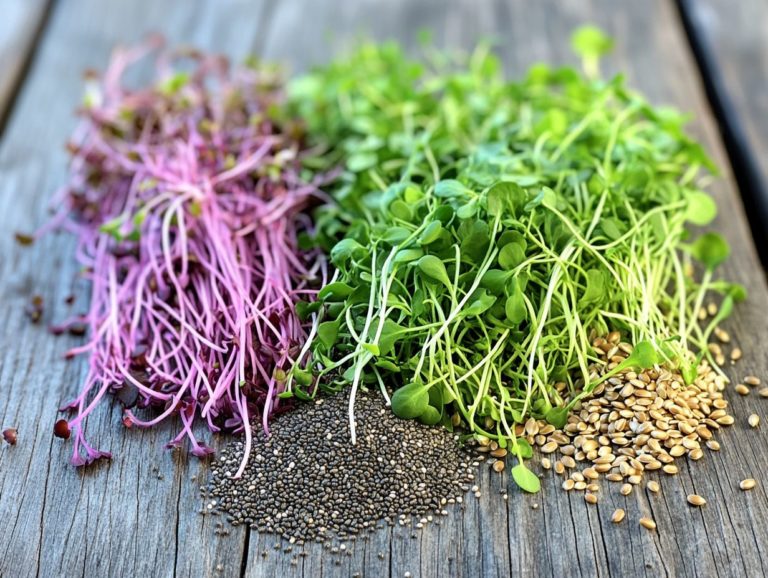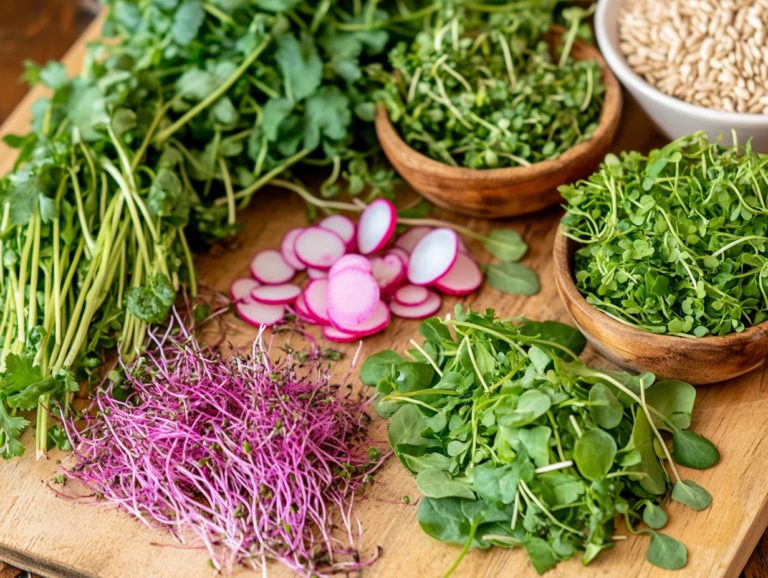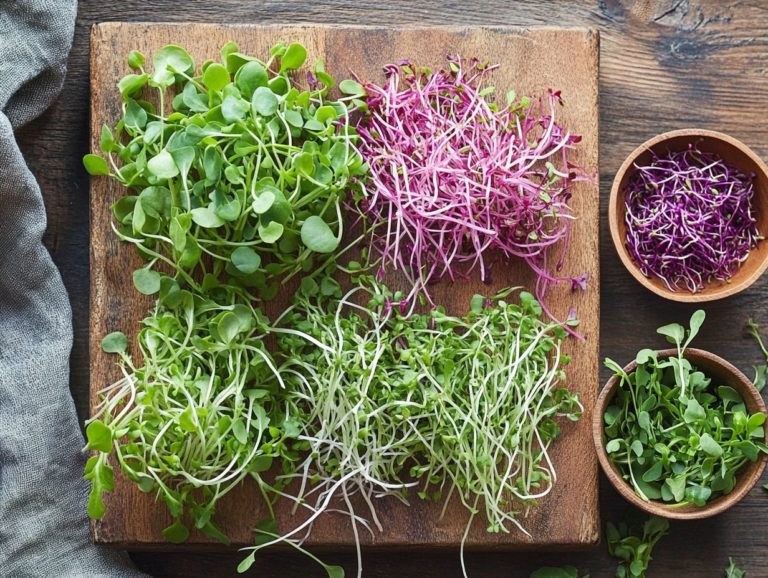Why Microgreens Are Essential for a Balanced Diet
Microgreens are vibrant young plants bursting with flavor and nutrients! They have taken the culinary world by storm, celebrated for their remarkable health benefits and versatility in the kitchen.
These greens don t just add a pop of color; they elevate the flavor and texture of your dishes while significantly enhancing your nutrient intake.
Whether you’re eager to infuse your meals with fresh, bold flavors or contemplating growing your own, this guide explores what microgreens are, their impressive nutritional value packed with powerful nutrients, and how to seamlessly incorporate them into your diet.
Uncover the potential risks associated with microgreens and discover how to select the perfect microgreen varieties to elevate your culinary experience to new heights!
Contents
Key Takeaways:
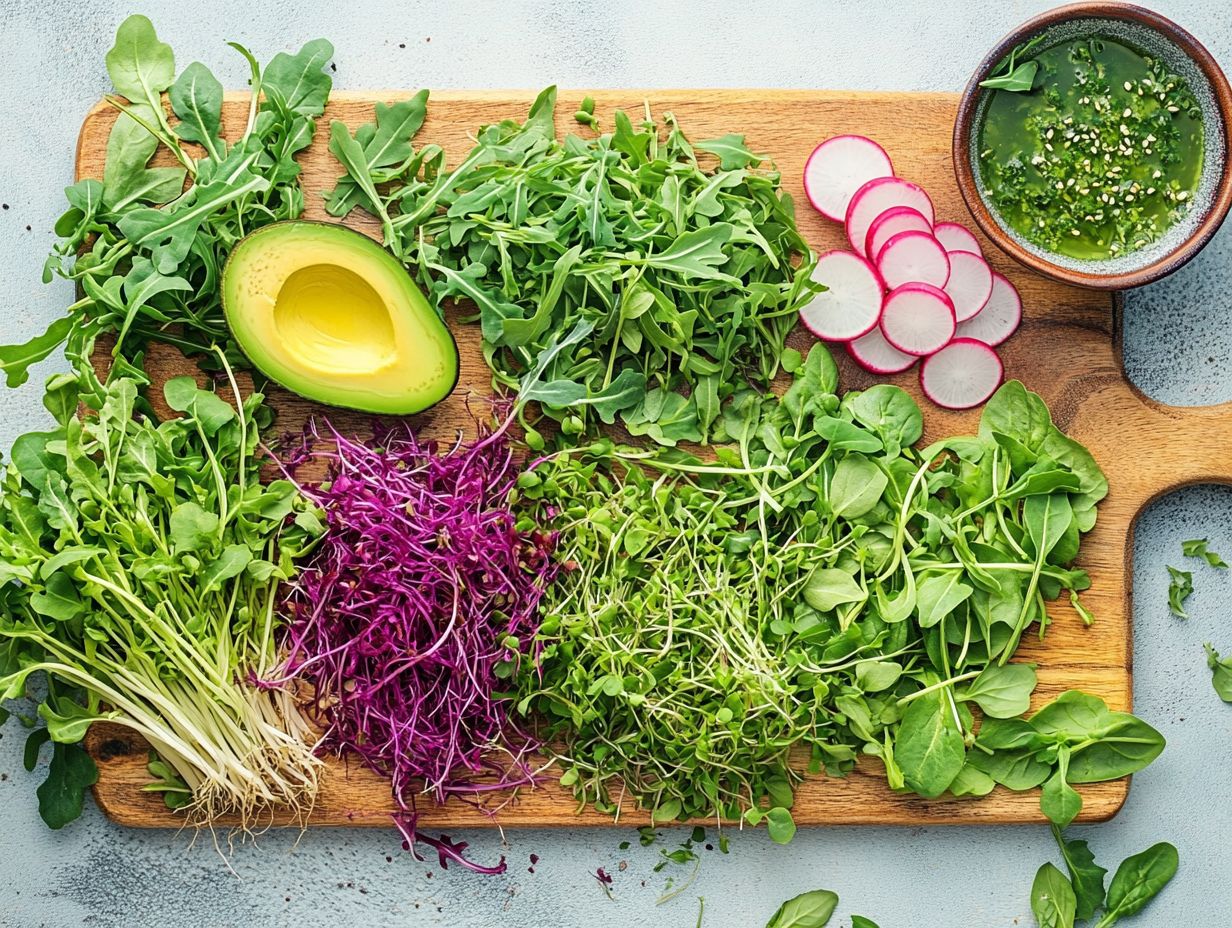
- Microgreens are young plants packed with nutrients that can transform your meals!
- Including microgreens in your diet can help improve your nutrient intake and enhance the taste and texture of your dishes.
- Growing your own microgreens at home is simple. Be mindful of food safety and allergy issues when enjoying microgreens.
Discover the World of Microgreens!
Microgreens are young plants that you harvest at an early stage of growth, usually within 7 to 21 days after germination. Their rise to fame as superfoods is no accident; these miniature greens are rich in nutrients and boast remarkable nutrient density.
Sourced from various plant families, microgreens are becoming increasingly popular in contemporary agriculture and urban farming. You ll appreciate them not just for their health benefits but also for their culinary versatility, as they add vibrant flavors and visual appeal to your dishes.
Definition and Nutritional Value
Microgreens are your go-to edible young plants, harvested shortly after germination. They re brimming with essential vitamins, minerals, and antioxidants that enhance their nutritional profile.
These petite powerhouses, like broccoli and spinach, are packed with vitamin C, vitamin K, and a variety of B vitamins, each playing a crucial role in supporting your overall health. Take broccoli microgreens, for instance; they re loaded with sulforaphane, a natural compound that may help protect your body from damage. Spinach microgreens, on the other hand, deliver a generous helping of iron and magnesium key players for maintaining your energy levels and keeping your blood pressure in check.
By incorporating these nutrient-dense greens into your diet, you enhance your overall wellness and potentially aid in diabetes prevention while lowering your risk of heart disease. It s a savvy move to elevate your meals.
Benefits of Including Microgreens in Your Diet
Incorporating microgreens into your diet provides a wealth of health benefits. These tiny powerhouses can enhance your nutrient intake, aid in diabetes prevention, and potentially offer protection against heart disease and cancer.
With such remarkable attributes, microgreens are an invaluable addition to any health-conscious diet.
Improved Nutrient Intake
Microgreens are known for their high nutrient content, offering a concentrated dose of vitamins, minerals, and health-enhancing compounds that elevate your overall nutrient intake in a health-conscious diet.
They serve as an excellent alternative or complement to traditional vegetables, especially if you’re navigating challenges like iron deficiency or malnutrition. By incorporating these tiny nutritional powerhouses into your meals, you can elevate your iron levels and essential nutrients without overwhelming your taste buds.
Whether you’re tossing them into salads, blending them into smoothies, or using them as a vibrant garnish, microgreens not only enhance flavor but also pack a nutritional punch.
Their versatility allows them to easily integrate into various dishes, promoting a balanced diet that caters to modern health needs. Ultimately, embracing these small greens can support your overall wellness and enrich your dietary diversity.
Enhanced Flavor and Texture
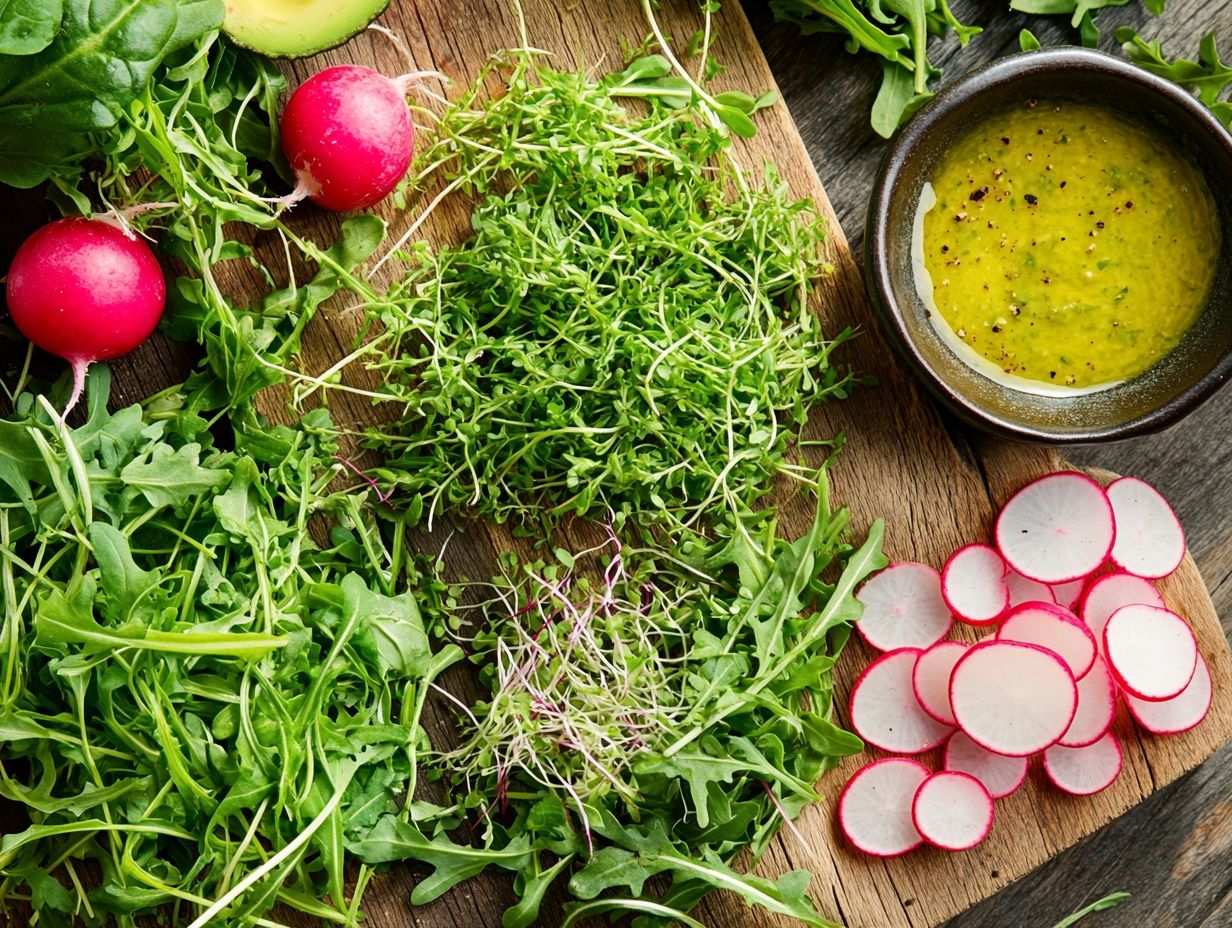
One of the standout qualities of microgreens is their remarkable ability to enhance the flavor profiles and textures of your dishes. They add vibrant color and a burst of taste that transforms meals into a true culinary art form.
These microgreens, often featuring varieties like arugula, mustard, and basil, can be used as a delightful garnish that beautifies your plates and introduces an array of unique flavors. In salads, they become an engaging main ingredient, providing a refreshing crunch and a peppery kick that perfectly complements traditional greens.
If you’re a sandwich lover, adding microgreens not only elevates the visual appeal but also infuses layers of complex taste, with radish microgreens delivering a zesty punch.
The culinary versatility of these greens allows you to pair them with everything from creamy dressings to spicy spreads, making them an essential element in your contemporary cooking experience.
How to Incorporate Microgreens into Your Meals
Incorporating microgreens into your meals is not just easy; it s a cooking experience waiting to unfold. You can experiment with a wide range of uses that enhance both raw and cooked dishes, all while championing healthy eating and embracing plant-based nutrition.
With microgreens, you have the perfect opportunity to elevate your meals and enrich your diet effortlessly.
Recipe Ideas and Tips
Here are some innovative recipe ideas and tips for incorporating microgreens into your meals, elevating both flavor and nutritional value.
These tiny greens pack a punch with their vibrant tastes and remarkable health benefits, making them perfect for both seasoned chefs and kitchen novices alike. For instance, consider adding peppery arugula microgreens to your salads for that extra zing, or blending sweet pea shoots into your smoothies for a naturally sweet boost.
When preparing dishes, using microgreens enhances the presentation and provides essential vitamins and antioxidants. Remember to add these greens at the end of cooking to preserve their delicate flavors and textures.
Explore unique pairings, such as topping a savory omelet with basil microgreens or using them as a garnish for soup to bring a refreshing touch to your plate.
Growing Your Own Microgreens
Growing your own microgreens at home offers a straightforward and gratifying experience, enabling you to embrace organic cultivation and savor fresh, nutrient-rich greens all while minimizing your environmental footprint.
Simple Steps for Home Cultivation
Cultivating microgreens at home is a delightful endeavor that can yield fresh greens in as little as 7 to 21 days, depending on the variety you choose.
Start by selecting a suitable container ideally, a shallow tray with drainage holes to let excess water escape. Fill the tray with high-quality potting mix, ensuring it’s evenly spread and gently compacted. Once you’ve sown your seeds, cover them lightly with soil and mist the area with water to encourage germination.
During the growth phase, providing ample light is essential. Aim for 12 to 16 hours of indirect sunlight or utilize artificial grow lights. It’s also vital to maintain consistent moisture without overwatering, while higher humidity can enhance growth.
When your microgreens reach a height of about 2 to 4 inches, it s time to harvest. Use scissors to snip them just above the soil line, and remember to do this in the morning when they’re at their freshest. Enjoy the fruits of your labor!
Start your microgreen garden today and elevate your meals!
Choosing the Right Microgreens

Selecting the right microgreens can elevate your meals and enrich your health-conscious diet. Each variety of microgreen presents distinct benefits, flavors, and nutritional profiles, allowing you to tailor your culinary experience to your specific needs.
Varieties and Their Unique Benefits
Each microgreen variety brings its own distinct benefits. Certain types are loaded with powerful nutrients, antioxidants, and polyphenols that can elevate your well-being and enhance your culinary adventures.
Take broccoli microgreens, for example. They re renowned for their high levels of sulforaphane, a compound celebrated for its potential role in cancer prevention and helping your body get rid of toxins. Then there are red clover microgreens, which offer a rich source of iron particularly beneficial for anyone facing iron deficiency, a common issue in various populations.
Don’t overlook sunflower microgreens either. They add a delightful crunch to your salads and are brimming with vitamins A, B, C, D, and E, all of which bolster your immune health. Incorporating these microgreens into your daily meals is a savvy choice for holistic health and a more enjoyable culinary experience. For more on their benefits, check out why microgreens are superfoods you need.
Potential Risks and Precautions
While microgreens present a wealth of health benefits, be aware of the potential risks and necessary precautions tied to their consumption, particularly regarding food safety and allergy considerations.
Food Safety and Allergy Concerns
It s also important to consider the environmental impacts that can arise from improperly sourced microgreens.
Food safety is paramount when consuming microgreens, especially since these delicate greens are often enjoyed raw. This can introduce health risks if not handled properly.
To ensure these vibrant greens are safe for your plate, adopt effective washing methods. Rinsing microgreens under cool running water can effectively remove any stubborn soil or pesticide residues that may linger.
Pay attention to your storage practices as well. Keeping them refrigerated in a breathable container helps maintain their freshness and prevents unwanted bacterial growth. Sourcing microgreens from reputable farms or local markets can significantly enhance their safety profile.
For those with food allergies, it’s crucial to read labels meticulously and familiarize yourself with common allergens that could be mixed in with these greens. Recognizing symptoms of an allergic reaction, such as hives or gastrointestinal distress, is vital for prompt action, ensuring that you can safely enjoy these nutritious plants.
Frequently Asked Questions
What are microgreens?
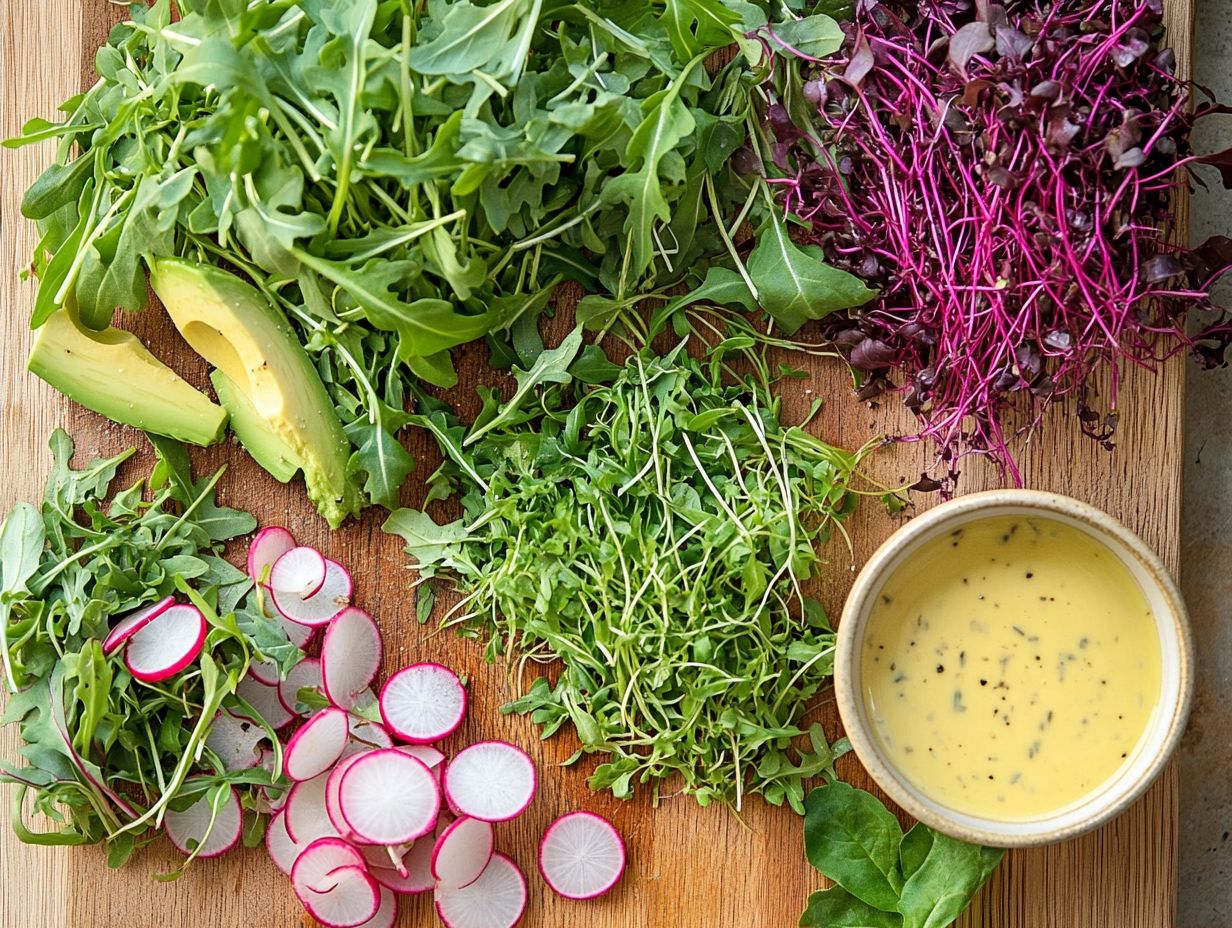
Microgreens are young, edible plants harvested after the first leaves sprout but before the true leaves develop. They are smaller than baby greens but bigger than sprouts.
Why are microgreens essential for a balanced diet?
Microgreens contain high levels of nutrients, such as vitamins, minerals, and antioxidants. They make a great addition to a healthy and balanced diet and provide a wide range of flavors and textures.
How do microgreens benefit our health?
- They have anti-inflammatory, anti-cancer, and anti-diabetic properties.
- They aid in digestion and boost the immune system.
- They improve heart health.
Can microgreens replace other vegetables in our diet?
While microgreens are packed with nutrients, they should not replace other vegetables. They should be consumed as part of a diverse and balanced diet.
Are microgreens easy to grow at home?
Yes, microgreens can be easily grown at home with minimal space and equipment. They can be grown in soil or using hydroponics, making it accessible for anyone to enjoy fresh microgreens at home.
How can microgreens be incorporated into our meals?
Microgreens can be added to a variety of dishes, such as:
- Salads
- Sandwiches
- Soups
- Smoothies
- Garnishes on main dishes
They can also substitute for traditional herbs and spices in cooking.
Try growing your own microgreens at home or adding them to your meals to experience their benefits and flavors!

